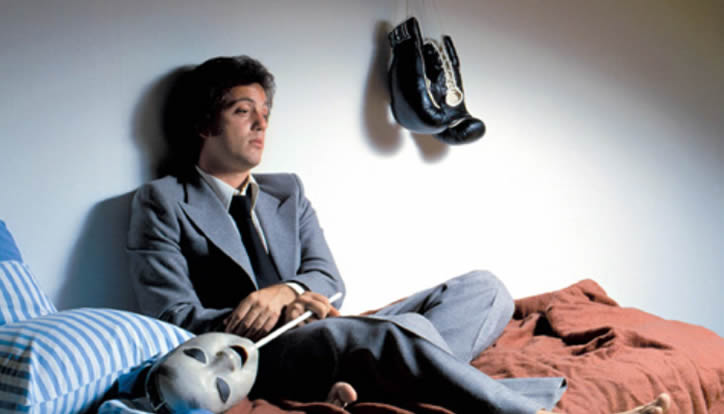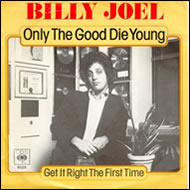The Stranger by Billy Joel

 There is a bit of irony in The Stranger being our selection as Album of the Year for 1977. Don’t get me wrong, this is a great album by Billy Joel. But it follows Turnstiles and precedes 52nd Street, which are even greater albums even though they may not be Album of the Year for their respective years. The truth is, 1977 was indeed a year of pop music (just check out all our reviews from the year) and this is one of the best pop albums of all time. Joel’s fifth studio album, The Stranger far surpassed the moderate chart successes of his previous four in the early to mid seventies. It reached #2 in the U.S. album charts, is Joel’s best-selling non-compilation album, and surpassed Simon and Garfunkel’s Bridge Over Troubled Water to become Columbia Records best-selling album to that date.
There is a bit of irony in The Stranger being our selection as Album of the Year for 1977. Don’t get me wrong, this is a great album by Billy Joel. But it follows Turnstiles and precedes 52nd Street, which are even greater albums even though they may not be Album of the Year for their respective years. The truth is, 1977 was indeed a year of pop music (just check out all our reviews from the year) and this is one of the best pop albums of all time. Joel’s fifth studio album, The Stranger far surpassed the moderate chart successes of his previous four in the early to mid seventies. It reached #2 in the U.S. album charts, is Joel’s best-selling non-compilation album, and surpassed Simon and Garfunkel’s Bridge Over Troubled Water to become Columbia Records best-selling album to that date.
All the material from the album was written exclusively by Joel and produced by Phil Ramone with most of songs composed in the studio. Joel credits Ramone for much of the album’s success due to his innovative production methods which complemented Joel’s songs. This team first worked together on 1976’s Turnstiles and built on the successful fusion of rock/pop and different genres introduced on that album. Joel favored big, sweeping melodies, but Ramone convinced him to streamline his arrangements and make the production more accessible.
The infectious, radio-ready material was complemented by a few vignettes that covered the middle-class ground that Bruce Springsteen was so successfully exploiting in the mid 1970s. But unlike Springsteen, Billy Joel also clearly constructed some artistic centerpieces that give The Stranger a feel of flow and depth. Although it lacks a true masterpiece like “Piano Man”, “Angry Young Man”, or “Zanzibar” from other albums, The Stranger is probably the most consistent throughout with very few moments of weakness.
 The Stranger by Billy Joel |
|
|---|---|
| Released: September 1977 (Columbia) Produced by: Phil Ramone Recorded: The Sound Factory, Los Angeles, July-September 1977 |
|
| Side One | Side Two |
| Movin’ Out (Anthony’s Song) The Stranger Just the Way You Are Scenes Form An Italian Restaurant |
Vienna Only the Good Die Young She’s Always a Woman Get It Right the First Time Everybody Has a Dream |
| Primary Musicians | |
| Billy Joel – Lead Vocals, Piano, Keyboards Steve Khan – Guitars Richie Cannata – Saxophone, Clarinet, Flute Doug Stegmeyer – Bass Liberty DeVitto– Drums |
|
The album launches with the sharp, underlying rock riff of “Movin’ Out (Anthony’s Song)”, a song exquisite in its pure oddness. Joel’s the piano takes a back seat for most of this entertaining song, lending space to the various other elements of sonic candy; guitar, saxophone, sound effects, and vocal harmonies. The coda features a slight variation of the main theme, solidifying the overall theatrical feel of the song. Aside from the protagonist, the song has many named, blue-collar characters, which paint a vivid picture of city life in a working class neighborhood. Bass player Doug Stegmeyer lent his Corvette to record the sound-effect in the song’s coda. “Movin’ Out” was also the title of a later Broadway musical based on Billy Joel’s songs.
The title song, “The Stranger”, moves from the quiet cabaret during the opening and closing sections to the disco fused body of the song. The harmonized vocal performance during the choruses are particularly pleasing during this stretch of the song. The signature whistling melody was originally supposed to be played by a clarinet, but Phil Ramone convinced Joel to use the whistle instead after he heard him doing it in rehearsal. “Just the Way You Are” was the biggest hit single off the album, reaching #3 on the pop charts and covered by scores of artists including Frank Sinatra. Joel makes no secret of his disdain of this song, written about his then wife and business manager, and had originally decided against including the track on the album and his band called it “lounge lizard” music. But with the encouragement of fellow artist Linda Rondstadt, Joel and Ramone decided to make a more interesting mix with synthesizers, a vocal chorus, and an extended saxophone lead by Richie Cannata.

“Scenes from an Italian Restaurant” is a multi-part suite which morphs from scene to scene in each of four distinct parts that explore rock jazz, blues, and show tunes. The song starts with the atmosphere of a piano bar (or Italian restaurant) and next it moves to a teenage hangout with “a song about New Orleans” and an excellent tenor sax lead. Then there is the song within the song, an upbeat piano tune originally written as the stand-alone “Ballad of Brenda and Eddie”. The song dissolves back to the Italian restaurant to the main theme for the outro. The seven-and-a-half-minute epic is the longest of Joel’s studio cuts.
The album’s second side is the fantastic “Vienna”, inspired by Joel’s young half-brother Alexander Joel (now a classical conductor), who grew up in Vienna. Billy Joel explained how the city was a perfect metaphor for a crossroads situation in life;
“During the Cold War, Vienna was between the Warsaw Pact nations and the NATO countries…it was between the Ottoman Empire and the Holy Roman Empire during the Middle Ages…it’s the place where cultures co-mingle”
Musically, the song is a calm piano song with great melodic vocals and a touch of accordion by Dominic Cortese, giving the song a legitimate European feel.
 I’ve always felt that “Only the Good Die Young” took on multiple meanings. There’s the topical and obvious narrative, which was quite controversial at that time as some felt it was anti-Catholic and the use of the name “Virginia” was a play on “virginity”. But there is also the philosophical undertone of examining one’s life and fate and there is the lamenting of the title itself, which is a profound statement. Still, as deep as this may be lyrically, it is completely light and fun musically. While it begins with a catchy piano part, the song is largely driven by the acoustic guitar of Steve Khan and has an “old time rock” feel.
I’ve always felt that “Only the Good Die Young” took on multiple meanings. There’s the topical and obvious narrative, which was quite controversial at that time as some felt it was anti-Catholic and the use of the name “Virginia” was a play on “virginity”. But there is also the philosophical undertone of examining one’s life and fate and there is the lamenting of the title itself, which is a profound statement. Still, as deep as this may be lyrically, it is completely light and fun musically. While it begins with a catchy piano part, the song is largely driven by the acoustic guitar of Steve Khan and has an “old time rock” feel.
“She’s Always a Woman” is a beautiful waltz played with a deep and melodic piano line, which pissed off a lot of women’s groups because of alleged stereotyping of the fairer sex. It has been described as a love song about a modern woman with quirks and flaws. “Get It Right the First Time” is an interesting and entertaining rock shuffle featuring a unique drum beat by Liberty DeVitto and a flute lead played by Cannata. The album concludes with the Ray Charles influenced “Everybody Has a Dream”, which includes an instrumental reprise of “The Stranger” to close out the album.
The skyrocketing success of The Stranger, was the first of a long string of Billy Joel albums which would achieve great commercial success over the next decade and a half until Joel “retired” from composing popular music around 1993. While this album fit 1977 perfectly, it does not sound dated in any way and that is why it is Classic Rock Review‘s album of the year.
~
Part of Classic Rock Review’s celebration of 1977 albums.





Quora
September 14, 2014 @ 4:41 am
What is the music in the opening bars of Billy Joel’s song “Strangers”?
It is originally composed music for the song. “The title song, “The Stranger”, moves from the quiet cabaret during the opening and closing sections to the disco fused body of the song. The harmonized vocal performance during the choruses are particula…
Blue October | River of Rock
October 3, 2017 @ 8:39 pm
[…] of the Blue by E.L.O. – 40th Anniversary The Stranger by Billy Joel – 40th Anniversary The Nylon Curtain by Billy Joel – 35th Anniversary Strange Days […]